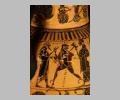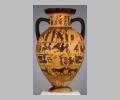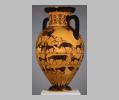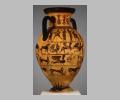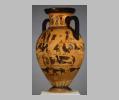| Collection: | Berlin, Antikenmuseen |
| Summary: | Side A: Birth of Athena. Side B: Fight. Below: rows of animals. |
| Ware: | Attic Black Figure |
| Painter: | Attributed to the Kyllenios Painter |
| Context: | From Caere |
| Date: | ca. 570 BC - ca. 560 BC |
| Dimensions: | H. 44.2 cm., d. 26.4 cm., d. foot 13.1 cm., d. lip 17.1 cm. |
| Primary Citation: | |
| Shape: | Tyrrhenian amphora |
| Beazley Number: | 310014 |
| Region: | Etruria |
| Period: | Archaic |
Condition:
The vase is in good condition. Some of the surface glaze has worn away.
Decoration Description:
Side A: Birth of Athena. In the center sits Zeus enthroned, his hands held to his head from which Athena springs forth. Eileithyia stands to the left and Demeter to the right, both holding out their arms to Athena. Zeus' thunderbolt is in his left hand, and he holds the edge of his mantle in his right. His long hair is bound at the neck and he wears a long, white chiton, a mantle, shoes, and a wide headband. Swans' heads decorate the back of his throne, and its legs end in lions' paws. Athena, who is about the same height as Zeus' head, is fully clothed and armed with helmet, spear and shield. Demeter and Eileithyia wear peploi, red mantles and red diadems. Hermes stands to the left of Eileithyia facing left. He is wearing a long chiton and a petasos, and carries a mantle draped over his arm, his herald's staff (kerykeion) held in his left hand. Next to him is Hephaistos who, having just split open Zeus' head, is running away to the left, his head turned back toward Zeus and Athena. He wears winged boots, a short tunic and mantle, and carries a double axe (labrys) over his shoulder. Dionysos, on the far left, stands facing the central group, one arm raised. He wears a long chiton, a mantle and a wreath, and holds a kantharos in his right hand. The figures to the right of the central group are incompletely preserved. They include, to the right of Demeter, a standing male figure (perhaps Poseidon) who faces right holding a staff. He wears a long chiton and mantle. To the right is a peplos-clad goddess facing left. Apollo stands on the far right facing right, his head turned toward the left. He holds his bow in one hand and his quiver in the other. A folding campstool with lion-paw feet stands nearest the handle of the vase.
Side B: Fight, with three pairs of combatants. The two hoplites in each pair face off with shields and spears raised. They stand with legs stiffly braced, the left leg forward. Each wears a short chiton, a Corinthian helmet and greaves, and carries a sheathed sword at his waist. The hoplite on the far left wears a cuirass. The shield device of his partner is a large rosette. All the warriors are young and unbearded.
Lower friezes: animals. The animals, arranged in heraldic groups of three or four, include sirens, sphinxes, lions, panthers, rams, a swan, a cock, and a bull.
Inscriptions:
The figures on side A are labelled, from left to right:
Short, unreadable inscriptions are decoratively arranged between the hoplites on side B.
Sources Used:
Other Bibliography:

